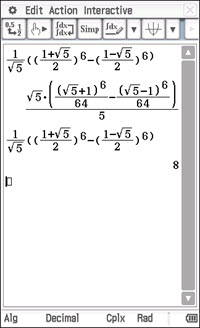I have been reading An Imaginary Tale – The Story of ![]() by Paul J Nahin, which is fabulous. There was a bit in chapter 4 where he found the closed form of the generalised Fibonacci sequence. I thought it would be a good exercise to find the closed from of the Fibonacci sequence.
by Paul J Nahin, which is fabulous. There was a bit in chapter 4 where he found the closed form of the generalised Fibonacci sequence. I thought it would be a good exercise to find the closed from of the Fibonacci sequence.
Just to remind you, the Fibonacci sequence is
![]()
and it is defined recursively
![]()
That is, the next term is the sum of the two previous terms, i.e.
![]()
Now the starting off point is slightly dodgy as it involves and educated guess as Paul Nahin writes,
How do I know that works? Because I have seen it before, that’s how! […] There is nothing dishonourable about guessing correct solutions – indeed, great mathematicians and scientists, are invariable great guessers – just as long as eventually the guess is verified to work. The next time you encounter a recurrence formula, you can guess the answer too because then you will have already seen how it works.
We start with ![]()
This means ![]() is
is ![]()
![]()
![]()
![]()
![]()
![]() or
or ![]()
Hence ![]() and we can use the initial conditions
and we can use the initial conditions ![]() and
and ![]() to find
to find ![]() and
and ![]()
When ![]()
(1) ![]()
When ![]()
(2) ![]()
From equation ![]() ,
, ![]() , substitute into equation
, substitute into equation ![]()
![]()
![]()
![]()
![]()
![]()
![]()
![]()
![]()
![]()
![]()
![]()
Does it work?
Remember the sequence is ![]()
If ![]()
![]()

As you can see it works!
